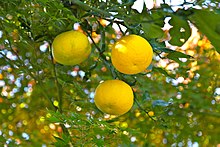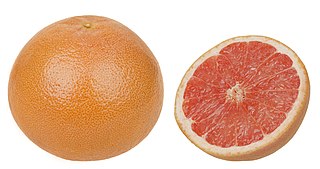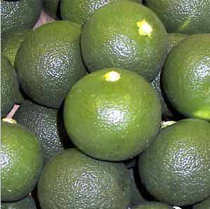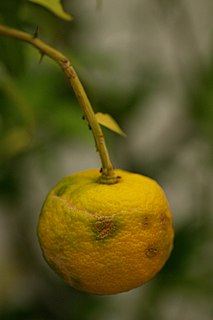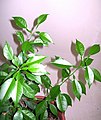
Ponzu (ポン酢) is a citrus-based sauce commonly used in Japanese cuisine. It is tart, with a thin, watery consistency and a dark brown color. Ponzu shōyu or ponzu jōyu (ポン酢醤油) is ponzu sauce with soy sauce (shōyu) added, and the mixed product is widely referred to as simply ponzu.
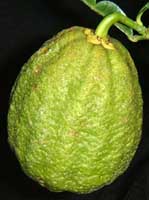
Citrus ichangensis, the Ichang papeda, is a slow-growing species of papeda that has characteristic lemon-scented foliage and flowers.

The pomelo, Citrus maxima or Citrus grandis, is the largest citrus fruit from the Rutaceae family. It is a natural (non-hybrid) citrus fruit, similar in appearance to a large grapefruit, native to South and Southeast Asia. The pomelo is one of the original citrus species from which the rest of cultivated citrus have been hybridized. The popular fruit is used in many festive celebrations throughout Southeast Asia.

Yuja-cha or yuja tea is a traditional Korean tea made by mixing hot water with yuja-cheong. Yuja tea is popular throughout Korea, especially in the winter. This tea is created by curing yuja into a sweet, thick, pulpy syrup. It is healthy and does not contain caffeine. They are often sold in markets and used in households as a common cold remedy. Yuja tea is made from the fruit Yuja, citron, or Yuzu, a japanese fruit. These fruits do not contain much juices, unlike other citrus fruits. They are able to cook in high temperatures without losing its tart flavor. Yuja fruits have an amazing fragrance. Its strong scent comes from the zest, juices, and essential oils. Yuja tea is both bitter and sweet. In addition, Yuja tea is a preservative, so it can be left out on a shelf or counter.
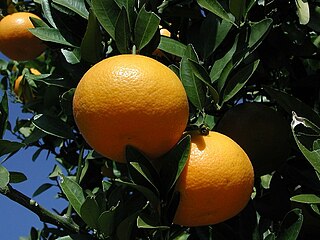
The iyokan, also known as anadomikan (穴門みかん) and Gokaku no Iyokan, is a Japanese citrus fruit, similar in appearance to a mandarin orange, arising from a cross between the Dancy tangerine and another mandarin variety, the kaikoukan. It is the second most widely produced citrus fruit in Japan after the satsuma mandarin.
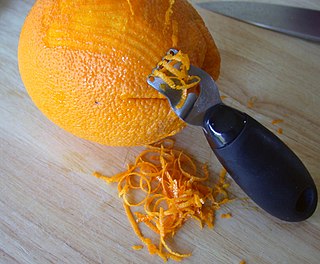
Zest is a food ingredient that is prepared by scraping or cutting from the outer, colorful skin of unwaxed citrus fruits such as lemon, orange, citron, and lime. Zest is used to add flavor to foods.
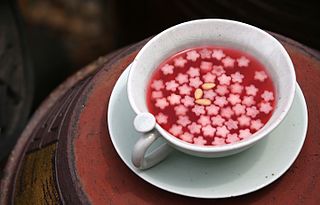
Hwachae is a general term for traditional Korean punches, made with various fruits or edible flower petals. The fruits and flowers are soaked in honied water or honied magnolia berry juice. In modern South Korea, carbonated drinks and/or fruit juices are also commonly added to hwachae. Hwachae is often garnished with pine nuts before it is served.
Yuja-hwachae is a variety of hwachae, Korean traditional fruit punch made with finely shredded yuja, Korean pear, and honey or sugar. In Korea, yuja are largely cultivated in the southern part of the Korean peninsula such as Goheung and Wando, Geoje, and Namhae. Therefore, yuja hwachae has been a local specialty of the Jeolla Province and Gyeongsang Province.

Jeonggwa is a crispy, chewy hangwa with vivid colors and a translucent look. It can be made by boiling sliced fruits, roots, or seeds in honey, mullyeot, or sugar water, then drying the slices, and optionally shaping them into flowers or other decorative forms. The candied fruits, roots, or seeds may have the similar texture to jam, marmalade, or jelly.
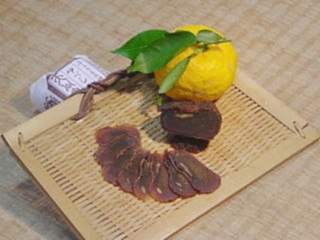
Yubeshi is a type of wagashi. It has several flavor and shape variations, most commonly walnuts or Japanese citrus, and can be round or square, but all yubeshi has a base of sticky rice or rice flour, sugar and soy sauce. The process of production is very labor intensive. A circle is cut out of the top of the yuzu and set aside. A wooden spatula removes the fruit and scrapes away the white pith of the yuzu, leaving only the zest. The fruit is then stuffed with a filling which can range from plain mochiko flour to a traditional blend of mochiko, shōyu, and other spices. The reserved top of the fruit is placed back in as a cap, and the whole thing is steamed repeatedly until the fruit is shiny and brown and the mochi has fully gelatinzed. The longer the product is stored, the harder the texture will become. Both the rind and filling are edible. Yubeshi can be served in many ways, whether sliced thin on top of rice dishes and salad, or softened in a warm soup dish.

The shangjuan, or Ichang lemon, is a cold-hardy citrus fruit and plant originating in East Asia.

Citrus taxonomy refers to the botanical classification of the species, varieties, cultivars, and graft hybrids within the genus Citrus and related genera, found in cultivation and in the wild.
Dangyuja is a Korean citrus fruit that is a specialty of Jeju Island. In Jeju language, it is called daengyuji. Dangyuja has a similar shape and flavour to yuja, but is genealogically a variety of pomelo.

Cheong is a name for various sweetened foods in the form of syrups, marmalades, and fruit preserves. In Korean cuisine, cheong is used as a tea base, as a honey-or-sugar-substitute in cooking, as a condiment, and also as an alternative medicine to treat the common cold and other minor illnesses.
